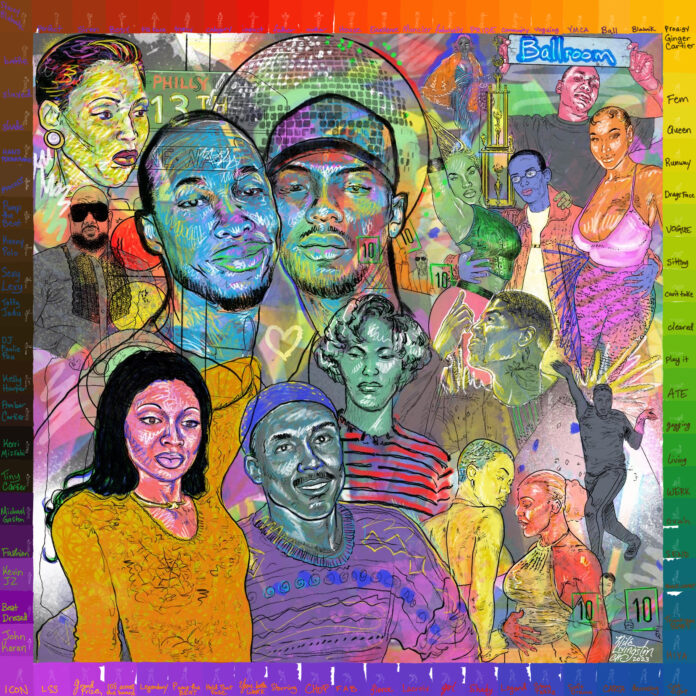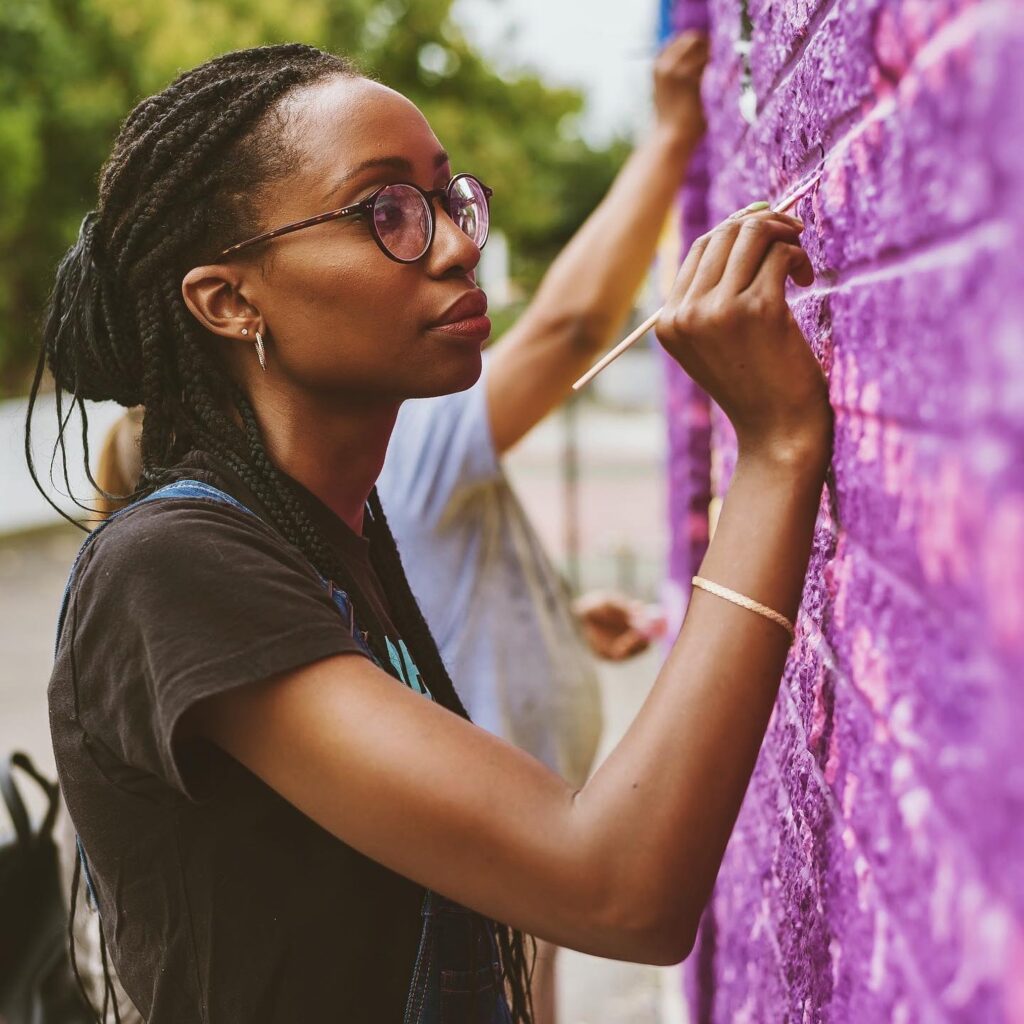
To honor the history of the Philadelphia Ballroom scene, a mural entitled “Finally on 13th” will soon be unveiled on 13th Street, between Pine and Spruce Streets, in the Gayborhood. It is the first mural to highlight Black and Brown LGBTQ+ Philly Ballroom icons. Ballroom icon King Mother Jacen Bowman conceived of the idea for the mural, and artist Nile Livingston designed it with input from other local Ballroom greats.
“We don’t have as many Black and brown queer murals in Philadelphia,” Bowman said. “There’s so many queer icons and legends and drag performers and everything else in the city who should be highlighted and spotlighted.”
Bowman thought of the idea for “Finally on 13th” when he was leaving the club Voyeur one night with Meechie Lanvin, another big name in the Philly Ballroom scene. Bowman brought the idea to the team at Philadelphia Mural Arts, who then selected Livingston to design and create the mural. From there, Bowman gave Livingston a sense of the Philly Ballroom scene by sharing stories and being vulnerable, and connected Livingston to others from the local Ballroom scene who were willing to share their experiences. Livingston also amassed archival photos, as well as Ballroom invitations, brochures and programs.
“We were looking at the mural that’s downtown on 13th and Locust; there’s a really pretty mural there,” Lanvin said. “That parking [lot] where that mural was at –– the generations of gays, especially the Black queers that grew up in Philadelphia –– for years, we hung in that parking lot. I remember as a young teenager being down there late at night and jumping rope and just having fun with your peers. That was our home away from home. 13th Street was our safe haven. [Jacen] said, ‘that should be us up there.’”
Featured in the mural are Bowman, Lanvin, Sinia Alaia, Jay Blahnik, Stacey Blahnik, Amber Cartier, Tiny Cartier, Kesha Ebony, Raphael Excellence, Michael Gaskins, Kelly Harper, Renee Karan, Kerri Mizrahi, Tonya Prada, Alvernian Prestige, Icon Amina Prodigy, Kevin JZ Prodigy and Mann Prodigy. Gaskins produced the first Ball in Philadelphia in August, 1989, according to the 2019 documentary “Legendary: 30 years of Philly Ballroom,” published by the Philadelphia Inquirer.
“I don’t think that there’s any mural that I can think of that shows this fullness of LGBTQ life in Philadelphia, or most other places around the nation,” Livingston said. “It’s about representation. It was important to me that the mural had an authentic voice.”
A Ball is a competition involving vogue dance, which originated from the Harlem ballroom scene in the 1960s. The style of Ballroom that lives on today is derived from the balls that queer and trans BIPOC communities created in New York in the 1980s. But vogue is only one component of Ballroom; there are also garment and facial components to Ballroom, which involve different labels like “foot and eyewear [and] high-fashion sportswear,” Raphael Excellence, founder of the House of Excellence, said in the Inquirer documentary. “Your looks should tell a story. Is it a Miami look? Is this New York chic? Is this jetsetter? Is it preppy chic? Is it hip hop? It should say something.”
Both Livingston and Bowman commented on the fact that although Ballroom may exist in mainstream culture, like in “RuPaul’s Drag Race” or “Pose,” those images of Ballroom are different from the intricacies of the underground scenes.
“We’ve seen Beyonce, we’ve seen Madonna, we’ve seen so many people utilize resources from Ballroom and put it on a main stage,” Bowman said. “It’s important that we are able to be the architect of our own stories, celebrate our own icons and legends, and celebrate our own Hall of Famers and pioneers.”
In 1989, Philly was the third U.S. city to host a Ball, apart from New York City and a town in North Jersey. Philly’s size and overall culture compared to New York made engaging in Ballroom a bit of a challenge when the scene was new, Lanvin said.
“You would go to New York, people see all types of things,” Lanvin added. “Philadelphia is a lot more closed minded, so for us to be able to bust through all the stigma — a lot of times as young queers, and even now catching public transportation, being ridiculed, going to these balls in makeup and drag — we had to be really strong.”
When Lanvin was coming out and getting involved in Ballroom culture in the 1980s and early 1990s, he described joining Ballroom houses, which are made up of fellow LGBTQ+ chosen family members, as places of refuge.
“For a lot of us, meeting these ballroom icon figures, gay parents and mothers and joining houses, was really what saved a lot of us and protected us,” Lanvin said. “Now we have rights to protect us. Back then, we only had these icons and these legends to look over us. A lot of us were runaways and didn’t have families to go back home to.”
For Kevin JZ Prodigy, Philly Ballroom “is ground zero if you ask me. Philly Ballroom gave me a place where I could be myself and be heard. It helped me help others find their voice.”
Bowman was recruited to the Ballroom scene in high school by Alvernian Prestige, the “unofficial mayor of Philadelphia’s Ballroom community,” according to the Inquirer documentary. Prestige asked Bowman to be a model, but he was really asking Bowman to join the House of Prestige.
“[Ballroom] changed my life because I was finally able to be seen for all of my uniqueness, all of my loudness, all of my creativity, my femininity — all the things that I was told that was too much in that space,” Bowman said. “Too much is never too much in that space. It was the first place that I felt free, that I felt seen, that I felt accepted. The things that you learn in Ballroom are priceless.”
Ultimately, Livingston hopes the mural inspires less hatred in people, they said.
“A lot of the figures in the mural have unfortunately passed away or have been killed,” Livingston said. “Because this particular community lives on the margins, there’s usually numerous oppressive attacks against the community. I think putting it on the wall will hopefully help people become more familiar and more open and loving to these groups of people that have created a separate family because the outside world has been a little bit harsh on them. I just hope that people can be more understanding and accepting and inclusive.”
